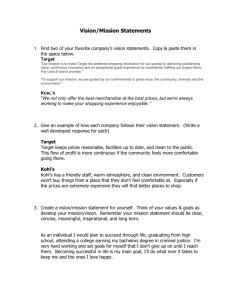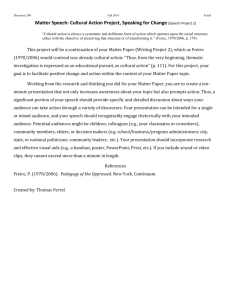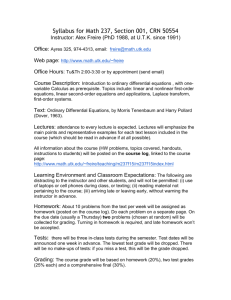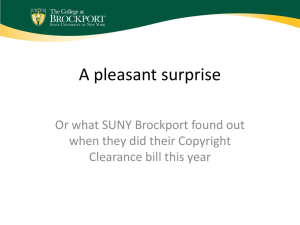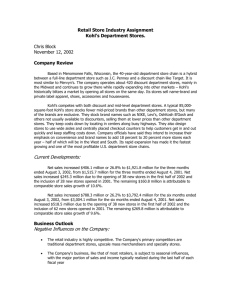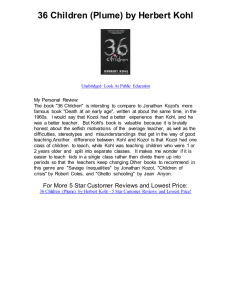A Student Teacher's Journey
advertisement
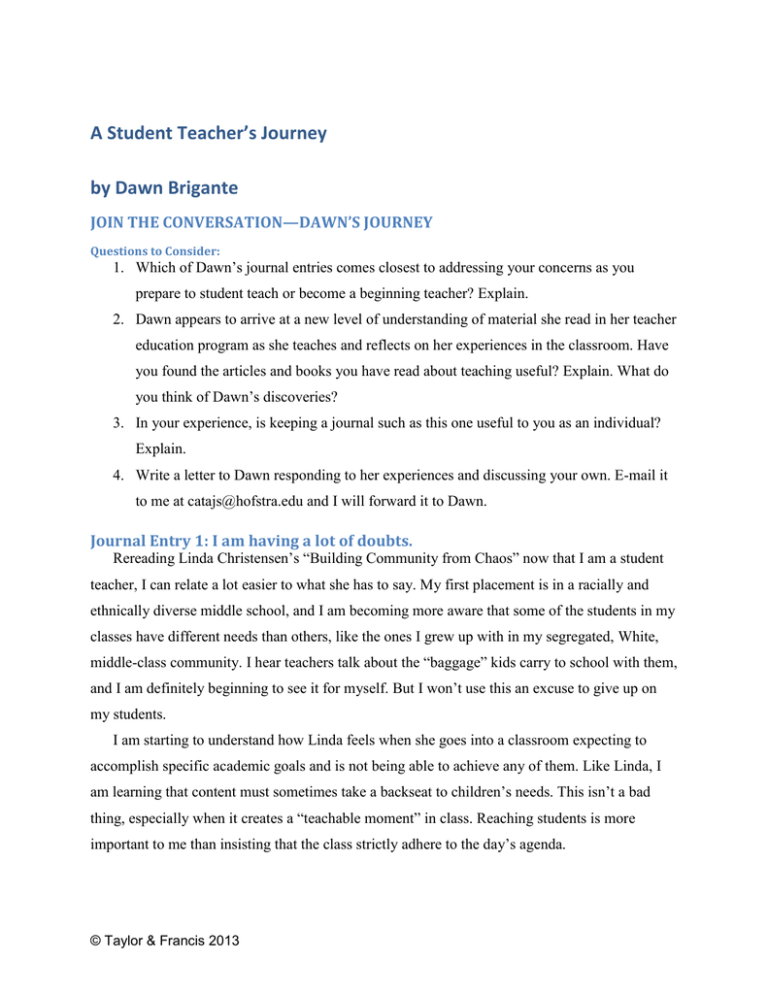
A Student Teacher’s Journey by Dawn Brigante JOIN THE CONVERSATION—DAWN’S JOURNEY Questions to Consider: 1. Which of Dawn’s journal entries comes closest to addressing your concerns as you prepare to student teach or become a beginning teacher? Explain. 2. Dawn appears to arrive at a new level of understanding of material she read in her teacher education program as she teaches and reflects on her experiences in the classroom. Have you found the articles and books you have read about teaching useful? Explain. What do you think of Dawn’s discoveries? 3. In your experience, is keeping a journal such as this one useful to you as an individual? Explain. 4. Write a letter to Dawn responding to her experiences and discussing your own. E-mail it to me at catajs@hofstra.edu and I will forward it to Dawn. Journal Entry 1: I am having a lot of doubts. Rereading Linda Christensen’s “Building Community from Chaos” now that I am a student teacher, I can relate a lot easier to what she has to say. My first placement is in a racially and ethnically diverse middle school, and I am becoming more aware that some of the students in my classes have different needs than others, like the ones I grew up with in my segregated, White, middle-class community. I hear teachers talk about the “baggage” kids carry to school with them, and I am definitely beginning to see it for myself. But I won’t use this an excuse to give up on my students. I am starting to understand how Linda feels when she goes into a classroom expecting to accomplish specific academic goals and is not being able to achieve any of them. Like Linda, I am learning that content must sometimes take a backseat to children’s needs. This isn’t a bad thing, especially when it creates a “teachable moment” in class. Reaching students is more important to me than insisting that the class strictly adhere to the day’s agenda. © Taylor & Francis 2013 I strongly believe teachers must provide students with opportunities to talk about the anger and sadness in their lives. Often it is considered unacceptable to express feelings such as sadness, depression, and anger in school. That is how students learn to bottle up their emotions, but they can only bottle them up for so long before they explode. Teachers and students should work together to design curricula and choose literature to read based on the interests of students. When I have my own classroom, I hope to use Linda’s suggestions for breaking down walls and stereotypes among students and creating classroom communities. It is important that students talk to one another. Many think they know everything they need to know about their peers: whose parents are divorced, who has no parents, who hangs out with the “wrong” crowd. They think that their first judgment is the final word. But when they get to really know others, when they find out that everyone has his or her own story, that everyone feels pain and experiences hardships and joys, they will think twice before doing anything hurtful or selfish. I like Linda’s idea of having older students teach lessons to elementary school children. The opportunity to act as role models provides positive experiences for the teenagers and for the younger students. Having high school students rewrite children’s books is a good way for students to express their understanding of the world, a world in which happy endings are not handed out on a silver platter; they must be struggled for and sometimes they never occur. I particularly responded to Linda’s ideas because right now I feel as if I am a kid teaching kids. I know right from wrong well enough, but that does not mean that I do the right thing all of the time. On Friday, I cursed while talking to a student, and I don’t know if I have lost or gained ground with him (maybe a little of both). I wonder if I have the right to say to kids, “Hey, listen to me, because I am your teacher, and I will teach you right from wrong.” Who am I to assume that position? I am probably more confused than most of my students. I am having a lot of doubts about teaching lately. I am unsure as to whether this is for me. However, I have decided not to make any decisions about the future until after the semester is over. Journal Entry 2: Where do teachers begin? When I began reading Herbert Kohl’s I Won’t Learn From You, I did not understand what he meant by “willed not learning.” I had read Kohl in the past, but I was unable to relate to what he was saying about the way certain students felt about school. It was not until recently that I began to understand the implications of his ideas. © Taylor & Francis 2013 When Kohl talks about students who choose not to learn because of their life experience or experiences in school with stereotypical, racist, or chauvinist curriculum and materials, he is taking the blame for failure off of the students. He makes it the teacher’s job to find solutions. I never really thought much about this before. As a high school and college student, I believed people didn’t learn because they had a lower ability level or because they gave in to peer pressure; it never was and probably still is not cool to be too smart. Recently I came face to face with an example of willed not learning. I met a young man in one of the classes I was observing who did nothing all period long, day in and day out. He was not motivated by anything related to school or schoolwork. The only thing that interested him was dramatic performances. He was eager to play any character, eager to be someone he was not, even if only for a moment. It was very difficult for me to understand how he could be so unmotivated and lifeless one moment and eager to perform the next. After observing him for a while, I noticed that this boy was extremely intelligent. When we could get him to take the tests, he easily got better test grades than those who had participated and studied. I asked some of his other teachers about him and found out that he did nothing in any of his classes, but they also thought he was very intelligent. One teacher told me that he had been through some kind of terrible tragedy more than a year before and that he had become unresponsive as a result. I could not understand why none of them had bothered to find out what the problem was and why no one was attempting to break through his wall. I tried to reach out to him the best way that I could. Although he was not my student, I remarked on how intelligent he was and told him he could do anything he tried, but that he had to try first. I did not accept blank test sheets when he handed them in. I gave them back to him and told him to make educated guesses. I could not change his life, but I tried to change his experiences for a few moments at a time. The questions I am left with for Kohl are “How does a teacher find out why a student has chosen not to learn?” and “Where do we, as teachers, begin?” I don’t know if this young man’s case would be considered “willed not learning” in Kohl’s eyes because his problem is not with the curriculum or the materials, but with himself and his reality. Maybe he feels as if he has been through enough and cannot deal with the trivialities of the day-to-day school routine. Maybe he feels alone, so he has turned off completely. I do not know where the root of the problem lies; I © Taylor & Francis 2013 only know that I would never allow a student to choose to fail without doing everything in my ability to bring him or her back. I have decided that I can only be a teacher if I have the opportunity to truly help my students. I want to work with the students that Kohl talks about because I believe that I am capable of getting through to them. I am sure that there is a lot of work involved with Kohl’s ideas for restructuring a class, but it is the kind of work teachers must be willing to do if they are teaching students and not simply content. Journal Entry 3: Say yes to students. Of all the books I read during my short “career” as an education student, none had quite the impact that Judy Logan’s Teaching Stories had on me. As a middle school English teacher, I can completely relate to Judy’s classroom and her approach to teaching, and I appreciate the candor with which she deals with the critical issues that confront adolescents and their teachers. Since completing the book, I have begun to think long and hard about the individual needs of my students and the ways a teacher can reach each one of them. One of the most important things I learned from Judy Logan is to say “yes” to students. Sometimes saying “yes” will be hard, but if I really want to make a difference and to make education relevant, I must take the risk. It will mean learning to loosen the reins and letting students pursue avenues that interest them. As a student teacher, I do not really control what is happening in the classroom, although when my cooperating teacher said a class was mine, I tried to make decisions I thought were right. On several occasions, students came to me with alternative ideas for assignments. I knew the only way I could empower them was to say, “Do it your way,” but I was afraid my cooperating teacher would feel I used poor judgment. I decided to say “yes” anyway, but kept it a secret between us. When they handed in their work, I was very pleased with the results. Recently I began a unit on how to write research papers, a subject that usually is a drag for students and teachers. After reading Judy Logan’s piece about her Woman’s History Quilt Project, I decided that papers should be about a famous woman in American history. I excluded contemporary pop culture personalities, and some students were disappointed with this limitation. As I went around the classroom to help them decide on people, several students asked if I would allow them to do musicians such as Courtney Love, Mariah Carey, Selena, and Janis Joplin. I hesitated at first, but I heard Judy Logan’s voice inside my head saying, “Yes! Yes!” © Taylor & Francis 2013 and I answered with a resounding, “Yes!!!” I detected a look of disappointment on my cooperating teacher’s face, but I did not let it change my decision. I asked myself what the goal was for this unit. My goal was to teach students how to write a research paper, and if they could learn that while writing about someone they were interested in, then I had done my part. I’m not here to make education a drag for kids. I also want my students to learn that there are strong women who are not written about in the history books and encyclopedias. In conjunction with the research paper assignment, I had them write about a positive female role model from their everyday lives. Many of them wrote about their mothers, family friends, and teachers, people who have had a profound influence in their lives. I think it was a good opportunity for students to see how much women do and are capable of doing. Emily Styles’ metaphor of curriculum as a window and mirror is a lot like Judy Logan’s approach to teaching and an important idea for new teachers to consider. Styles believes that students should be able to see themselves mirrored in the content of the curriculum, and they should also be able to look through the windows of curriculum to see other people’s stories. I think students who are given the opportunity to tell their own stories will be better listeners to the stories told by other people. Empowering students to talk with and to listen to one another is one of the first steps to creating a democratic, liberating dialogue in the classroom. When students believe that their voices are worth hearing, they will speak loudly and clearly and more often. This is one of the major goals I have for my classroom and my students. I want to provide students with a forum that frees them from the restrictions that bind them and so they can begin telling their own stories. I thank Judy Logan for showing me how it can be done. Journal Entry 4: I wondered if everything I had learned was a waste. When I began student teaching, I believed on faith that experiential learning was the best way for a student to experience education. I believed that every lesson had to be hands-on and if I could not find an engaging way to teach something, I was a failure. But as my student teaching experience progressed, I kept asking myself, “Are my students really learning?” I constantly wondered if students in an experiential classroom are short- changed. Maybe these students need a teacher to get up in front of the room and say, “You need to know this . . .” or “This means this . . .” I began to doubt myself more and more as I heard veteran teachers refer to experiential classrooms as “cut and paste” classrooms. I wondered if everything I had learned to that point © Taylor & Francis 2013 was a waste. When I read John Dewey’s Experience and Education, I was relieved to see he was addressing some of my questions. Dewey discusses the “problem of discovering the connection which actually exists within experience between the achievements of the past and the issues of the present.” While Dewey raises points worth considering, his writing was very difficult to get through and I was left unsatisfied. I was waiting anxiously for him to provide me with the answers. What I now realize is that experiential learning means that teachers have to come to their own conclusions based on experiences working with students in their classrooms. I have begun to notice that different classes need to be taught differently. One of my classes is filled with an academic mix of “lower than grade-level” and “grade-level” students. This makes it difficult to aim lessons at everyone. Sometimes I feel as though I am either leaving some students behind or teaching “down” to the group. I must admit that my expectations with them are not as high as with my other classes. If I can get them to read, to understand, and to think critically from time to time, I feel that I am doing my best. But am I? Sometimes I find myself accepting “I don’t know” and silence when I know that they are capable of much more. Recently I did a timeline project with them, and I could tell that they were excited to be doing something other than reading and discussing the text. If I had realized this at the start, I would have done a lot of things differently. But I was told early on that it was not in this “class’s makeup” to participate in open discussions or presentations. More than anyone else, these students need to have intellectually exciting experiences that provide them with incentives to attend class and learn. Reading and discussing the textbook does not motivate them to do anything but wait for the bell to ring. Journal Entry 5: A pedagogy of hope. I really cannot relate to Paulo Freire’s Pedagogy of Hope. I cannot find the connection between the types of oppression he talks about and my duty as an educator. This may not be due to any fault of mine or of Freire’s. It may be, as he suggests, a shortcoming of education in the United States. I know this sounds confusing, but it took me a while to disentangle my thoughts, so it might take you a while to make sense of them. Until now, I had absolutely no need to understand ideas like those presented by Freire. They are not part of education in the suburban schools where I was a student and now student teach. They are not tested on final exams or requirements for © Taylor & Francis 2013 admission to top colleges. There is no time in the day set aside for a teacher to investigate the cultural backgrounds of students, to get to know their needs, and to develop strategies to help them overcome oppression. Maybe these are priorities in other countries or other parts of the United States, but not here. Here, as Herbert Kohl points out, “students are judged by their conformity and obedience rather than their intelligence in dealing with the problems that they and their communities face.” Maybe that explains why Freire seems so alien to “mainstream” America. I don’t know what a new teacher in a traditional suburban school district can do to bring Freire’s ideas and hopes into fruition; I don’t know if a new teacher can really do anything. I hear more about not rocking the boat than I hear about helping to provide students with a “democratic, liberating education.” I definitely agree with Freire’s claim that traditional schooling consists of “banking” information into students’ minds and that this system assumes they bring nothing worth knowing with them. I have tried to open up the lines of communication with students and to let an uninhibited dialogue flow. There is an awful lot I do not know and I am willing to be taught by them. Unfortunately, many of my students are uncomfortable expressing themselves in class. I worry that Freire’s approach is threatening to students, teachers, and the parents whose hardearned dollars pay my salary. I am not sure where to go from here or what to do about the things raised by Freire. To what degree can I really make a difference? The problem with reading literature such as this book is that once we are confronted with the issues, we can no longer claim ignorance; we can never turn back. Journal Entry 6: The hardest thing I have ever had to do in my life. I was asked what I learned during my student teaching experience. I find that question difficult to answer because I learned so many things about the type of person and educator I am, about people in general, and about the students in my classes. With all of the knowledge I gained, I still have many unanswered questions, and some feelings I have not even formulated into questions yet. I hope to find some answers as I write this, and I hope that other answers, and new questions, become clearer to me when I am teaching. I feel as though I have changed drastically as a person over the past months. I faced a challenge and I am proud of what I have accomplished. I survived all of those days when © Taylor & Francis 2013 I thought that I could not last another moment or that I could not possibly face another class filled with teenagers. I learned that stress can do strange things to your body and I found out it is okay to scream in your car and to vent your frustrations, as long as your windows are closed and the stereo is playing loudly. If I am ever a cooperating teacher, I will try my hardest to be supportive of my student teachers and to offer constructive criticism that actually is constructive. I have learned that I do know a lot about literature, but that I have a lot to learn about everything else. I realize now that teaching is not an easy job; there is so much involved beyond which can be taught in a methods class. Student teaching was by far the hardest thing I have ever had to do in my life, but also the most rewarding. I gained valuable experience and I truly understand how difficult it is to teach a full day of classes. Having a support system in our seminar helped me gain insight into myself as a teacher and a person. The books and articles we read and wrote about provoked my thoughts about what I want to accomplish as a teacher and how to go about accomplishing them. © Taylor & Francis 2013
